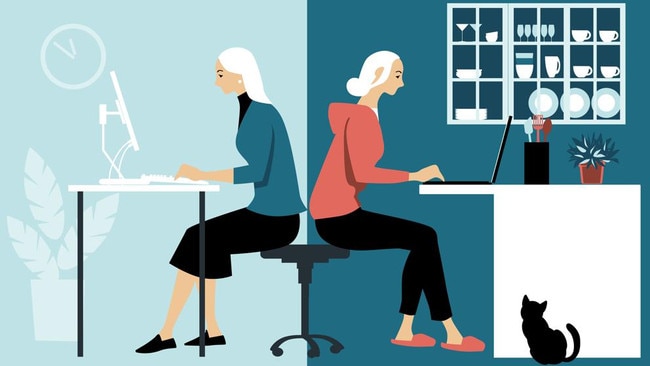Is WFH a drain on productivity? It’s a complex picture

In fact, there are no absolutes, more of a muddling through. Firms and workers are searching for their own sweet spot, usually some form of hybrid model. But policymakers face a similar dilemma. Our policy structures – in workplace relations, work health and safety, transport pricing and even housing – have a quaint 20th-century feel, struggling to handle a modern, technology-enabled shift.
Although Covid-19 was the catalyst, there is a natural economic and technological momentum towards remote work.
Before the industrial revolution, most people worked from home (in farming, skilled trades or household drudgery). Industrialisation brought workers into the factory and, later, the office. The centralised physical workplace was born, aided by transport technology that made it cheaper and faster to move people from home to work and back again.
In the past 30 years, travel speeds stagnated while the cost of communications and information technology plummeted.
No surprise, then, that people prefer working from home to a long commute.
Even so, most jobs cannot be done remotely. The Productivity Commission has estimated that about 65 per cent of occupations require a physical presence. The remaining 35 per cent are a grey area: work from home may be physically possible, but does it make economic or commercial sense?
In general the evidence is inconclusive, for three main reasons. Studies tend to point to average effects, but each worker’s capacity to work productively from home is different, shaped by their own characteristics, workplace circumstances and home environment.
Even where working from home is found to be bad for productivity on average, it still would be possible for firms to select the workers, days and tasks most amenable to productive remote work.
Second, in many modern service industries, output (hence productivity) is hard to measure. Workers are not making widgets and there is a subjective quality dimension to what knowledge-based workers do.
Some studies find overall output is higher but productivity (output per hour) is lower. Part of this comes from workers working longer hours by using some of the freed-up commute time – a cost to workers that firms do not always consider.

Third is the time dimension. The benefits of working from home (the avoided commute and increased flexibility) are tangible and felt in the here and now; the costs (missed learning and creativity that can come with physical co-location) are long term and mostly unobserved.
For example, research suggests that experienced workers benefit more from remote work. But workers generally give and receive less feedback and interact less when working remotely.
This could produce a short-run boost to productivity but at the cost of knowledge sharing and mentoring.
Much of the research relies on surveys and subjective assessments of productivity (including by workers themselves).
One hard-data alternative is to look at property prices. Price movements reflect the ebb and flow of remote work and attitudes to it, made by thousands of firms and millions of workers.
Our work at the e61 Institute measures the premium people are willing to pay to live closer to the centres of Australia’s capital cities. It finds that the premium declined sharply during the pandemic but this trend has since unwound. All else equal, it shows many workers are rediscovering the value of proximity to the city, and perhaps their employers see renewed value in physical presence.
But this isn’t the full picture. Demand for living on the urban fringe remains high. Before the pandemic, rents on the urban fringe were about 40 per cent lower than in the inner city and lower than in the middle ring. But with the onset of the pandemic rents on the fringes rose to the same levels as in the middle ring. The data suggests this may now be a long-term trend.
After all, few workers can work fully remotely. The hybrid model implies fewer commutes a week, making the larger house on the urban fringe more attractive (even with the occasional long commute).
Housing policy supports efficient labour markets when it caters to these preference shifts. Stamp duty and planning rigidities limit our ability to adapt efficiently to new technological realities.
Another lesson – given the diversity, uncertainty and constantly evolving approach to remote work – is that regulation should tread lightly. There are large gains from getting remote work right, but “right” will look different for different firms and workers.
Australia’s workplace relations system is essentially collective: the National Employment Standards set economy-wide rules; awards set rules for industries; and enterprise agreements set collective arrangements for workplaces.
But remote work is highly individualised. Broadbased entitlements or reviewable “rights to request” are unlikely to be the answer. The right to disconnect also has the look of a blunt regulatory proxy for the nuanced give-and-take that has always been part of flexible work.
In a sense the work from home debate is a misnomer. There is no single answer but a multitude of individual solutions, based on experiment and adaptation. Mass-produced, industrial era regulation sits ill with the information age.
Michael Brennan is chief executive of e61 Institute and former chairman of the Productivity Commission. Aaron Wong is a senior research economist at e61 Institute.
More Coverage
 In general the evidence is inconclusive, for three main reasons. Studies tend to point to average effects
In general the evidence is inconclusive, for three main reasons. Studies tend to point to average effects But remote work is highly individualised. Broadbased entitlements or reviewable “rights to request” are unlikely to be the answer
But remote work is highly individualised. Broadbased entitlements or reviewable “rights to request” are unlikely to be the answer



The debate over working from home elicits strong opinions but little clarity or consensus. Is it the great liberator of our time? A drain on productivity? A trap for young workers? A slippery slope to outsourcing? Can it be all of the above?